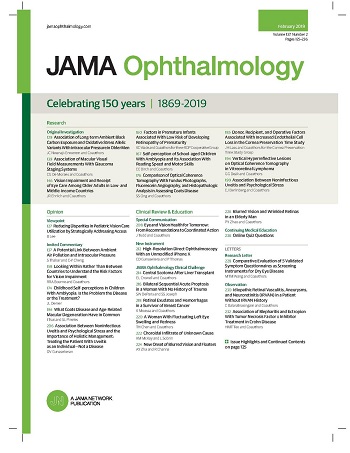Founder Homozygous Nonsense CREB3 Variant and Variable-Onset Retinal Degeneration.
IF 9.2
1区 医学
Q1 OPHTHALMOLOGY
引用次数: 0
Abstract
Importance Uncovering the genetic basis of inherited retinal diseases (IRDs) can enhance both diagnostic accuracy and the development of targeted treatment strategies. Objective To evaluate the association between a homozygous nonsense variant in CREB3 with IRDs. Design, Setting, and Participants Thirteen patients with a clinical diagnosis of retinitis pigmentosa or cone-rod degeneration were analyzed by whole-genome sequencing (WGS) and whole-exome sequencing (WES). Clinically, patients presented with 2 main phenotypes, rod-cone and cone-rod dystrophies, demonstrating variable electrophysiological and fundoscopic findings. Expression analysis was performed on patient-derived skin fibroblasts using the reverse transcription-polymerase chain reaction and Western blot analysis, and by interrogating previously published retinal single-cell RNA sequence data. Immunohistochemistry staining was performed on wild-type mouse retinal sections using an anti-CREB3 antibody. Patients with variable phenotypes of IRDs were recruited from 3 medical centers in Israel and Italy. Ophthalmologists clinically diagnosed patients at the relevant medical centers and referred them for genetic screening. WES and WGS were performed at different national and international centers, and the findings of the previously unreported gene were shared between investigators. Exposures CREB3 and IRDs. Main Outcomes and Measures The main outcome was evidence supporting an association between CREB3 and IRD. Measures included WES, WGS, and immunohistochemistry staining. Results A founder homozygous nonsense variant in CREB3 (c.881G>A, p.Trp294*) was identified in 13 patients from 4 unrelated families; 12 descendent from North-African Jewish origins and 1 from Italian origins. All patients manifested retinal degeneration with varying ages at onset. In patient-derived fibroblasts, the variant mRNA transcript generated a truncated CREB3 protein. Expression analysis and immunohistochemistry staining revealed CREB3 RNA and protein expression in various retinal cell types, indicating its vital role in photoreceptor function. Conclusions and Relevance This study found an association between CREB3 and IRDs. CREB3 was previously shown to be upregulated following ultraviolet radiation. This might contribute to the extensive clinical variability observed in this relatively large cohort of homozygous patients with the same truncated variant.创始人纯合无义CREB3变异和变发型视网膜变性。
揭示遗传性视网膜疾病(IRDs)的遗传基础可以提高诊断准确性和制定有针对性的治疗策略。目的探讨CREB3基因纯合无义变异与IRDs的关系。设计、环境和参与者采用全基因组测序(WGS)和全外显子组测序(WES)对13例临床诊断为视网膜色素变性或锥杆变性的患者进行分析。临床上,患者表现为两种主要表型,杆状-锥体和杆状营养不良,表现出不同的电生理和眼底检查结果。使用逆转录聚合酶链反应和Western blot分析对患者来源的皮肤成纤维细胞进行表达分析,并询问先前发表的视网膜单细胞RNA序列数据。采用抗creb3抗体对野生型小鼠视网膜切片进行免疫组化染色。从以色列和意大利的3个医疗中心招募了具有可变表型的ird患者。眼科医生在相关医疗中心对患者进行临床诊断,并将其转介进行基因筛查。WES和WGS在不同的国家和国际中心进行,研究人员之间共享了先前未报道的基因的发现。暴露creb3和IRDs。主要结果和测量主要结果是支持CREB3和IRD之间关联的证据。测量方法包括WES、WGS和免疫组织化学染色。结果在4个无亲缘关系家族的13例患者中检出1个CREB3创始人纯合无义变异(c.881G>A, p.Trp294*);12个北非犹太人后裔,1个意大利后裔。所有患者均表现为视网膜变性,发病年龄不同。在患者来源的成纤维细胞中,变异mRNA转录物产生截断的CREB3蛋白。表达分析和免疫组织化学染色显示CREB3 RNA和蛋白在各种视网膜细胞类型中表达,表明其在光感受器功能中起重要作用。结论和相关性本研究发现CREB3与IRDs之间存在关联。CREB3先前被证明在紫外线照射后上调。这可能有助于在具有相同截断变异的相对较大的纯合子患者队列中观察到广泛的临床变异性。
本文章由计算机程序翻译,如有差异,请以英文原文为准。
求助全文
约1分钟内获得全文
求助全文
来源期刊

JAMA ophthalmology
OPHTHALMOLOGY-
CiteScore
13.20
自引率
3.70%
发文量
340
期刊介绍:
JAMA Ophthalmology, with a rich history of continuous publication since 1869, stands as a distinguished international, peer-reviewed journal dedicated to ophthalmology and visual science. In 2019, the journal proudly commemorated 150 years of uninterrupted service to the field. As a member of the esteemed JAMA Network, a consortium renowned for its peer-reviewed general medical and specialty publications, JAMA Ophthalmology upholds the highest standards of excellence in disseminating cutting-edge research and insights. Join us in celebrating our legacy and advancing the frontiers of ophthalmology and visual science.
 求助内容:
求助内容: 应助结果提醒方式:
应助结果提醒方式:


